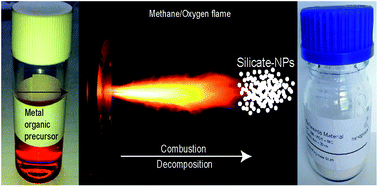Development and characterization of custom-engineered and compacted nanoparticles as calibration materials for quantification using LA-ICP-MS†
Abstract
The flame spray technique was used to produce a nano-material with a customized composition. Liquid organic precursors of Si, Ca, Ti, Mg, Fe, and Al in a concentration similar to the matrix of the well-known NIST SRM 610 glass standard were mixed with a selection of rare earth elements (Ce, Gd, Ho, and Tb), precious metals (Ag, Au, Pd, Pt, Rh, and Ru) and Pb at concentrations of approx. 400–500 mg kg−1. The liquid precursor mixture was sprayed and collected as nanopowder, compacted to pellets and analyzed by solution and laser-ablation inductively coupled plasma mass spectrometry. The bulk composition of the material was determined in several aliquots of the powder, either 25 mg or 50 mg. Electron microprobe analyses were carried out to further characterize the major element composition of the pressed nano-material. The pellet was ablated using different laser ablation systems with an aim of assessing the micro-scale homogeneity of the produced material. The manufactured material is homogeneous for major elements and REE's similar to the NIST glass (<5% RSD). However, the distribution of the PGE's showed some larger spatial variation in the order of <7.5%. In addition it is shown that contamination during production leads to heterogeneous distribution of Pb and Ag. Based on the results achieved for Ru, Rh, Pd, Au, Pt, Mg, Ti, and Fe, which are either absent or not available in sufficient concentration levels in NIST glass, it is demonstrated that flame spray synthesis allows production of suitable customized matrix-matched calibration materials for micro-analytical techniques.

- This article is part of the themed collection: Geological applications of laser ablation

 Please wait while we load your content...
Please wait while we load your content...